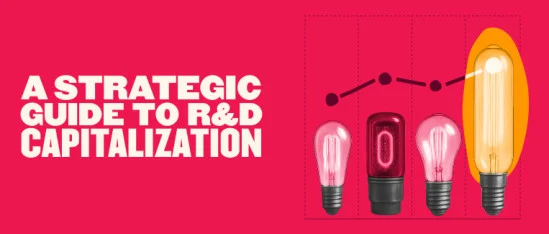Deciding whether to capitalize or expense R&D costs can feel like one of the great accounting puzzles for SaaS finance teams. While recent updates to IRS Section 174 require businesses to capitalize and amortize R&D spending for tax purposes, financial reporting standards still offer some flexibility.
In this article, we’ll walk through the difference between expensing and capitalizing R&D costs in your financial statements—and explore when each approach might make more sense for your business.
What is R&D capitalization?
R&D capitalization means recording certain R&D costs as an asset on your balance sheet, instead of recognizing them as an expense in your profit and loss statement right away.
To capitalize R&D costs, you’ll first need to identify which expenses qualify—such as the development of internal or external software—and then amortize those costs over their expected useful life. Keep in mind, only specific types of R&D spending meet the criteria for capitalization under GAAP. The rest must be expensed as they’re incurred.
We’ll get into the technical details shortly. But first—why might you choose to capitalize in the first place?
What’s the benefit of R&D capitalization?
The main advantage of R&D capitalization comes down to how you assess profitability.
One of the core principles of GAAP is that revenue should be matched with related expenses. But when it comes to software development, it often takes a long time before today’s investments turn into tomorrow’s sales.
If you expense all your R&D costs at once, your profitability picture looks skewed. That’s because the immediate expense—which can be significant—isn’t aligned with the future revenue it helps generate.
Capitalization addresses this by shifting R&D costs from operating expenses on the P&L to an asset on the balance sheet. These costs are then amortized and written off gradually over time.
The result? A boost to reported net income and EBITDA, as well as improvements in profitability measures like return on assets and return on equity.
GAAP requirements for R&D capitalization
Software costs for SaaS companies generally fall into two categories—internal use and external use.
- Internal-use software is built to support your own team, like project management tools or other applications that make day-to-day work more efficient
- External-use software is a product you’re creating to sell to customers
When it comes to capitalization, this distinction makes all the difference.
Identifying eligible R&D costs
Whether your software is for internal use or external sale, the types of R&D expenditures that can be capitalized are the same. These may include:
- Labor costs for software engineers
- Software licenses
- Materials used during development
- Third-party development fees
So, if the eligible costs are the same, why does the distinction between internal-use and external software matter? Because when development activities qualify for capitalization depends on two things: the type of software (internal-use or external) and the stage of development.
Rules for internal-use software
ASC Topic 350 outlines capitalization rules for internal-use software, which can be broken into three stages:
- Preliminary stage: This is the “drawing board” phase, when you’re designing the concept and mapping out how to build it. Costs at this stage can’t be capitalized.
- Development stage: Once coding and testing begin, certain costs become eligible for capitalization.
- Implementation stage: After the software is fully developed and ready to use, you can no longer capitalize new costs. Ongoing maintenance, upgrades, or fixes must be expensed.
Rules for external (marketed) software
ASC Topic 985 governs capitalization for software intended for sale, also divided into three stages:
- Planning stage: Costs such as prototyping, design, and analysis must be expensed.
- Development stage: Costs can be capitalized, but only after the software reaches “technological feasibility.” This milestone means you’ve determined the product can be built and will likely deliver value to customers—often demonstrated by a working version.
- Post-release stage: Once the product is available for sale, new costs must be expensed.
For SaaS products, which are constantly evolving, this can raise a question: Can you capitalize the development of new features? The answer is yes—but only before the product becomes available for sale. The same rule applies to bug fixing.
Capitalizing R&D costs: examples
Example 1: Internal-use software
Imagine you spend $500,000 developing software that helps your team operate more efficiently. Because your company is still early-stage with limited revenue, you’re concerned this expense will reduce reported profitability.
Instead, you choose to capitalize the cost. You estimate the software’s useful life at five years, so you set that as the amortization period. Each year, $100,000 ($500,000 ÷ 5) is expensed, instead of recognizing the full $500,000 in year one.
You’re still paying $500,000 upfront, so it’s recorded as a cash outflow on your cash flow statement. But on your balance sheet, the asset value increases, and your P&L shows smoother, more manageable expenses over time.
Example 2: External-use software
Now imagine you spend $1 million developing a new SaaS product for customers. Under GAAP, you can only capitalize costs after achieving technological feasibility and before the initial go-to-market push.
Because you use an agile approach, each feature is developed and released quickly, leaving only a small window between feasibility and launch. You determine the benefit of capitalization is minimal, so you expense the full $1 million on your P&L.
Should I capitalize my R&D costs?
The decision depends on two main factors: project size and timing.
- Project size: Capitalization isn’t simple. It requires detailed tracking and can add work for your finance team, potentially slowing down month-end close. To keep things manageable, many companies set a minimum cost threshold for projects they consider for capitalization.
- Timing: In agile development, the gap between reaching technological feasibility and going to market can be very short. This is one reason large tech companies, like Alphabet and Meta, typically expense their R&D rather than capitalize it.
It’s also worth remembering that capitalization is an accounting treatment—it affects financial reporting, not actual cash flow. Your business isn’t generating more cash; you’re just spreading recognition of expenses over time.
If optimizing net income is important for valuation, capitalization can help. But it’s not a substitute for building a profitable product. Long-term margins won’t change—so start with a strong product and solid product-market fit before worrying about capitalization.
Key takeaways
- R&D capitalization lets SaaS companies record development costs as assets, improving EBITDA and net income.
- GAAP rules differ for internal-use vs. external-use software, with capitalization allowed only during specific development stages.
- Eligible costs include labor, software licenses, and third-party development fees.
- Agile teams may struggle to capitalize due to short windows between feasibility and launch.
- Financial tools help automate tracking and ensure GAAP compliance.
Capitalizing R&D costs: how financial tools can help
R&D capitalization is a strategic accounting choice that can smooth expenses, improve certain financial metrics, and spread out tax burdens. But don’t let the pursuit of profitability on paper distract from building true profitability in practice.
Whether you decide to capitalize or expense, modern financial software tools can help you track costs over time and understand their impact on growth. They can also simplify month-end close by centralizing data and providing a clearer picture of when and how to capitalize R&D in line with GAAP.
R&D capitalization FAQs
Recommended For Further Reading
What documentation is required to support R&D capitalization for audit and compliance purposes?
Payroll records are key, especially showing time spent on capitalizable activities like coding or testing. Issue tracking history from tools like Jira, Asana, or Linear can also help. For external-use software, design documentation may be needed.
Is R&D capitalization a type of CapEx?
Yes. When R&D costs are capitalized, they move from the P&L to the balance sheet as a capital expenditure (CapEx).


